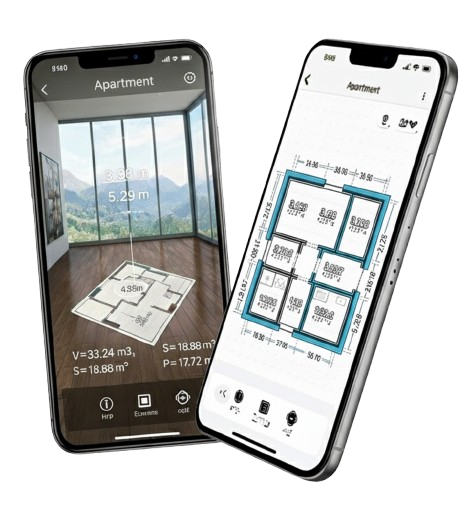Apartment plans—both 2D floor plans and 3D models—are crucial for interior design, real estate sales, and renovation planning. Until now, creating such technical architectural drawings required manual drafting or using online programs (e.g., Archiplaner.pl), which was time-consuming. Now, thanks to LiDAR technology in iPhones and the AdPlan application, you can quickly and easily scan an entire apartment and receive a ready-made digital layout of rooms—complete with dimensions and a spatial visualization—in literally just a few minutes. What’s more, AdPlan automatically creates an accurate apartment floor plan without the need to draw from scratch, eliminating measurement errors and allowing you to immediately use the data for design arrangements or property valuation. Below, we provide a step-by-step guide on how to plan your layout using AdPlan—from preparation, through the 3-minute scan, to exporting the results.
Note: The phrase “in 3 minutes” refers to scanning a typical single room or a small apartment. Larger apartments and single-family homes will take proportionally more time (e.g., a full house measurement might take ~10 minutes), but it will still be quick and easy compared to traditionally drawing a plan from scratch.
Apartment Floor Plan Online – What to Prepare Before Starting To ensure a smooth apartment scan, it’s worth preparing a few things beforehand:
The 3-Minute Process of Creating Apartment Plans – From Scan to Plan LiDAR scanning continuously reconstructs the geometry of a room, automatically creating a digital model. The AdPlan application uses the iPhone’s laser scanner (LiDAR) to measure the room in real-time and build its model. An average scan of a multi-room apartment takes just a few minutes—as shown in the tutorial, scanning two rooms takes about 5 minutes. Below are the steps of this process:
Scanning the Perimeter and Walls (Automatic Geometry Detection) Start the LiDAR scan by pointing the phone at the floor and walls of the room. Walk around the interior perimeter, holding the device steadily. As you move, AdPlan automatically detects walls, corners, and other architectural elements—continuously creating a complete floor plan on the screen. You don’t need to sketch anything manually—the app draws the room outline itself. Thanks to built-in intelligence, even details such as window and door openings, recesses, and pillars are recognized (the phone registers these objects during the scan). The result is a 2D apartment plan outline that reflects the actual layout of all walls (both load-bearing and partition walls). During scanning, try to move smoothly; at key points—e.g., corners or near larger furniture—slow down to give the LiDAR time to fully map the surroundings. After walking the entire perimeter of a room, you will get a closed room contour. The application will also automatically recognize transitions between rooms (doors) and can start scanning the next room if it is connected to the first.
Adding Height and Openings (Doors/Windows) and Room Names Once you finish scanning the floor outline and walls, AdPlan may ask you to define the room height. On LiDAR-equipped devices, just one tap is enough to measure the ceiling height—the laser scanner precisely determines wall height. This is important for generating a correct 3D model. The application should automatically mark the position of doors and windows in the floor plan (if LiDAR detected them during the scan). If necessary, you can manually add or correct openings—e.g., if a window was obscured and not captured, you can quickly insert it in the appropriate place on the plan. At this stage, it’s also worth naming individual rooms on the plan (e.g., kitchen, bedroom, bathroom), which will facilitate later orientation, especially with a larger number of rooms. AdPlan automatically divides the space into separate rooms—it detects partition walls and assigns room names if you provide them. You can also view wall elevations (vertical projections)—the application generates not only a horizontal plan but also a wall layout with marked openings, allowing you to verify, for example, the heights of windows or doors in individual rooms.
2D Floor Plan and 3D Model Preview, Verification, and Point Correction After collecting all data, the application automatically creates a full 2D floor plan and a 3D model of your apartment. On the screen, you will see a traditional 2D technical drawing with dimensions (wall lengths, room areas, etc.) and you can switch to a three-dimensional model view—a ready visualization of the interior from a spatial perspective. Carefully review these results. Verify the dimensions—AdPlan automatically calculates, among other things, the perimeter of each room, the floor area (square footage), and the height and area of the walls. Compare the values obtained with documentation (if you have it) or perform one control measurement (e.g., measure the length of one wall with a tape measure) and compare it with the value on the plan. This reference check will help ensure that the scan accurately reflects the scale—if necessary, you can make minor point corrections in the application, such as moving a marked wall corner by a few centimeters. Generally, however, this is not necessary—LiDAR measurements are highly precise (around ±1 cm error), meaning you get an accurate floor plan of your apartment without painstakingly measuring every wall. If you notice a missing element (e.g., a small window wasn’t marked) or a minor inaccuracy, use AdPlan’s manual mode with automatic corners—it allows you to quickly adjust the wall layout and add missing corners/segments while maintaining precision. After verification, you can be sure that your digital plan reflects reality—both in terms of room shape and dimensioning.
Multi-Storey and Irregular Shapes What about measuring multiple storeys or irregularly shaped rooms? AdPlan handles these too. The application supports multi-floor mode—you can add successive project floors and scan, for example, the ground floor and then the first floor of a house within one consistent plan. After scanning the first floor, the user selects the option to add the next floor plan and similarly performs the scan on the next storey. The program then allows seamless switching between floor plans, which is useful, for example, for a developer presenting the layout of multi-level apartments and homes. As for irregular shapes—e.g., rooms with sloped ceilings, rounded walls, or pillars—3D scanning also works perfectly. LiDAR records surfaces of any shape (floors, walls, ceilings, even arches and slopes), ensuring that the resulting model will be faithful to the actual layout. In more challenging conditions (e.g., an attic apartment with roof slopes), it’s worth remembering to perform wall scans at several height cross-sections: AdPlan typically measures the outline at floor level, but you can additionally point the camera higher to capture changes in wall shape at ceiling height. The application can also handle the presence of furniture or built-ins—AdPlan 3D algorithms can filter such objects and focus on permanent structural elements. As shown in the video, the system even recognizes obstacles in the room (e.g., large wardrobes, air conditioners) and allows you to set reference points for precision. As a result, even non-standard rooms will be rendered faithfully and technically correctly, and you will get a plan that takes into account all bends and angles present in reality.
Export and Sharing Plans Once your 2D/3D apartment plan is ready and verified, it’s time to use it. AdPlan allows you to export plans in several formats, meeting various recipient needs:
You can generate exports in the application with a few clicks—you choose the format, and AdPlan creates a file that you can save to the cloud or send. Sharing plans is very simple: you can send the ready PDF or CAD file via email, messenger (Messenger, WhatsApp, etc.), or share it on a network drive for colleagues. All projects are also stored in the cloud as part of your AdPlan account, so you and your team have online access to them from anywhere. You can work concurrently on multiple devices—e.g., an architect can edit further project details on a computer while an investor views the plan on a phone. Cloud integration and support for standard formats mean AdPlan seamlessly integrates with the existing workflows of design offices, real estate agencies, or construction companies.
It’s worth noting that unlike some free online tools, AdPlan provides professional results without watermarks. For comparison, while you can draw an apartment plan in the free online version of Archiplaner, the exported image will be marked with a logo (watermark)—only the paid version allows you to download the file without this mark. AdPlan immediately generates a clean, accurate technical drawing ready for commercial use, increasing the credibility of your documentation and presentations.
Best Practices for High Accuracy Finally, here are some tips to ensure your 2D and 3D floor plan is as accurate and architecturally correct as possible:
With the above tips, you will get an accurate and reliable plan—ready for both technical and presentation purposes. Laser scanning of interiors is the future, happening now—it saves time, minimizes errors, and allows you to focus on the actual work instead of redrawing plans.
Create a 2D/3D Apartment Plan in AdPlan – From Scan to Export in Minutes. You don’t need to be an architect or a graphic designer—just a smartphone. If you haven’t used AdPlan yet, try this app and see how quickly you can visualize any interior in the form of a professional floor plan.
Download AdPlan and start your journey with instant plan creation—your online apartment plan could be ready in just a few minutes from now!

